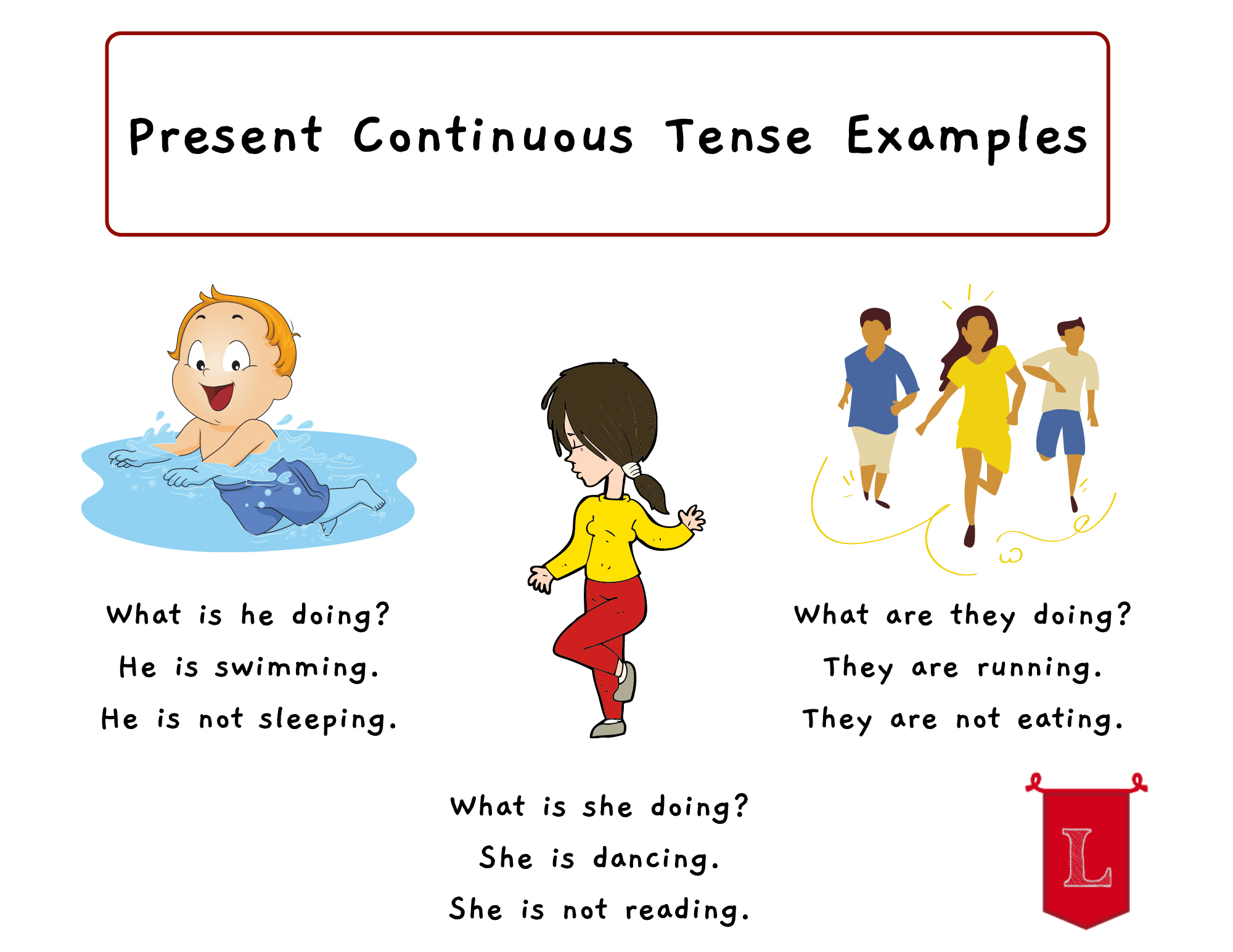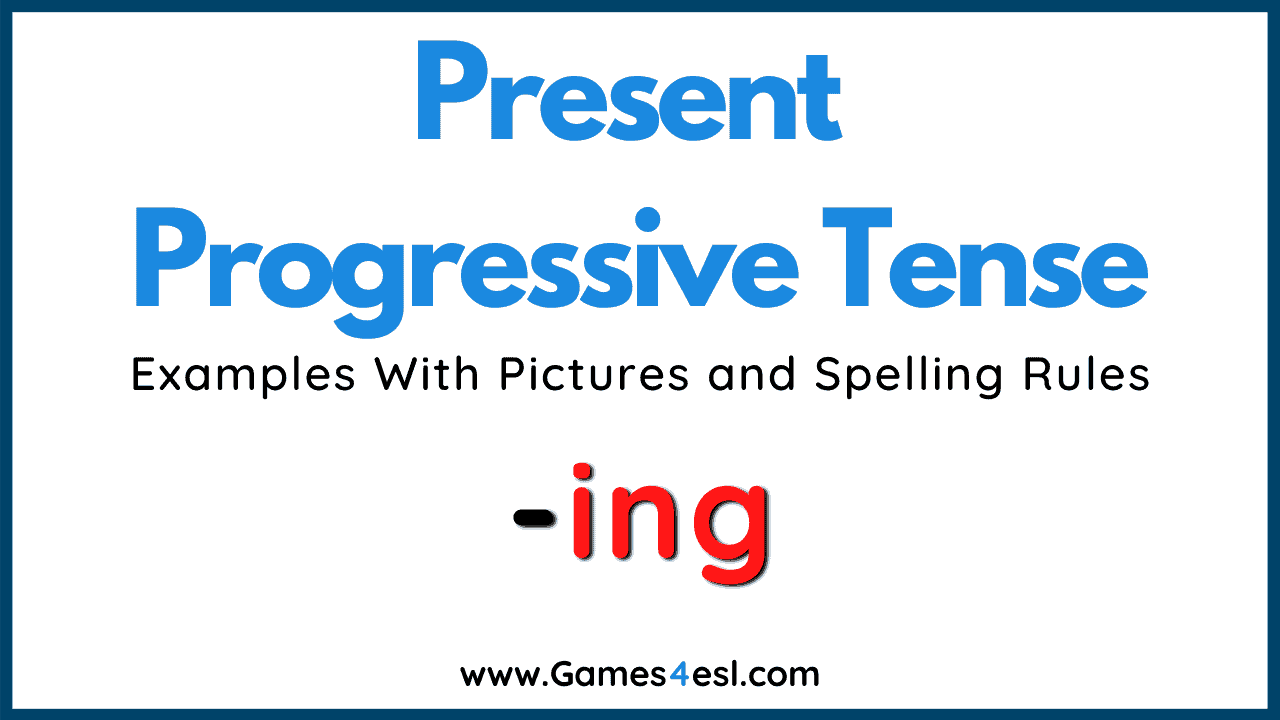
What is Present Progressive Tense? Definition & Examples Video
Examples of Present Progressive Tense Verbs 1. Affirmative Sentence Yoona is calling the police at this very second. Bogum is looking for his bracelet on the wet grass. They are completing the posters in the computer lab. Cleese and Jill are crouching under the dinner table. The kindergarten students are gathering around a small turtle. 2.

The Learners Nook
With verbs that end in e, to make the present progressive tense, drop the e and add -ing.For example, the verb make becomes making in the present progressive tense.. Here are some present progressive examples and example sentences which follow this rule: make - making - Mom is making a cake.; smile - smiling - She is smiling.; write - writing - Chris is writing a letter to his.

Example of present continuous tense English vocabulary words, English
Present Progressive Examples The best way to get a sense of how the present progressive is used is to review examples that appear in books, movies, and in common speech. Take the following example from "Beautiful," a 2009 novel by Amy Reed: "I am looking at my piece of pizza. I am watching pepperoni glisten.
:max_bytes(150000):strip_icc()/PresentProgressive-5b2c40623de4230036eb5b53.png)
Definition and Examples of the Present Progressive Tense
Learn How to Prepare for Your Progressive Tense with Our Practice Tests & Tutorials. Available in All Subjects - Online Lessons That Work on Your Schedule. Start Today!

😱 Writing in present tense examples. Present Continuous Tense Exercise
The present progressive tense, which consists of the auxiliary verb "be" plus a verb ending in "-ing," is used to describe actions that are currently occurring or that are still in progress but have not yet finished; the actions are still happening in the present moment. 1. You are starting the project. (start + ing = starting) 2.

Present Progressive Tense 1 ภาษา
Simple Present Present Progressive; actions that occur in a sequence. Example: They take a taxi to the station, check the timetable and get on the train.: actions that are in progress at the moment of speaking. Example: The Smiths are going on holiday. At the moment, they are standing in front of the time table.: actions that occur according to an official schedule or programme

Present continuous tense (Present progressive tense) Present
The Present Progressive Tense Spelling Tip Verbing (Present Participle) Add ing to most verbs. Ex. play > play ing, cry > cry ing, bark > bark ing For verbs that end in e, remove the e and add ing. Ex: slide > slid ing, ride > rid ing For verbs that end in ie, change the ie to y and add ing. Ex: die > dy ing, tie > ty ing

Present Progressive Tense Rules and Examples Tenses rules, Spelling
Here are some examples of verbs in a progressive tense: The Past Progressive Tense I was going. He was seeing. The Present Progressive Tense I am going. He is seeing. The Future Progressive Tense I will be going. He will be seeing. The progressive tenses are recognizable by the present participle (i.e., the word that ends "-ing").

The Present Progressive Tense Part 1 YouTube
Present Progressive Tense Examples: Verb: to clean We are cleaning the garage on Sunday. Note: simply add "-ing" to the end of a verb that ends in a consonant that does not have a short vowel sound Verb: to run He is running the race well. Note: Most verbs that end in short vowel sounds will require an extra consonant before adding "ing"

PPT Progressive Tenses PowerPoint Presentation, free download ID
The present continuous (also called the present progressive) is a verb tense used to refer to a temporary action that is currently taking place. It can also describe future plans (e.g., "I am throwing a party next week").

Present Progressive Tense English Grammar Handout Docsity
July 6, 2023 The present progressive is one of the most used tenses among the 12 tenses and that's why it is important to learn it well. We use the present continuous to talk about events which are in progress at the moment of speaking: I am riding my bike I am taking an online class We are discussing the project She is reading a book now

Present continuous, past continuous Tenses english, Present
Present Progressive Tense. English uses the concept of tense to communicate an action's place in time. For example, in the sentence James threw the ball to first base, the infinitive verb "to throw" is written in the past tense to let us know that this action occurred in the past as opposed to the present or the future.. The tenses have both progressive and nonprogressive forms to.

Present Perfect Progressive Present perfect, English language
The present progressive tense forms with a variation of to be coupled with a verb in the present participle form. A verb with a present participle form will be a verb with an "ing" ending. For.

Present Progressive Tense
The above examples of Present Progressive Tense are here to help you understand and use this tense properly and naturally. You should also get familiar with its usage and rules - visit the Present Progressive Tense page to help you with that. For exercises visit the Present Progressive Exercises. Check out the other tenses:

Present progressive tense or present continuous tense Artofit
Verbs Present tense Present continuous Present continuous Level: beginner The present continuous is made from the present tense of the verb be and the -ing form of a verb: We use the present continuous to talk about: activities at the moment of speaking: I'm just leaving work. I'll be home in an hour. Please be quiet. The children are sleeping.

PRESENT PROGRESSIVE TENSE, TUTORIAL VIDEO GRADE 8TH YouTube
The present continuous (present progressive) tense is a way to convey any action or condition that is happening right now, frequently, and may be ongoing. It adds energy and action to writing, and its effect helps readers understand when the action is happening.